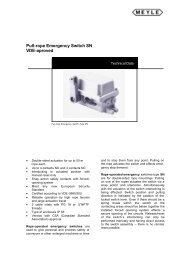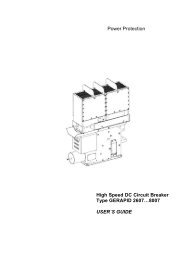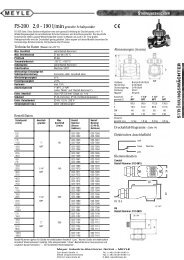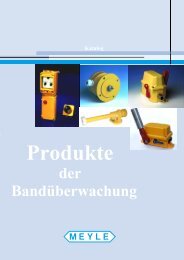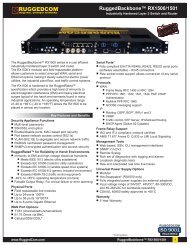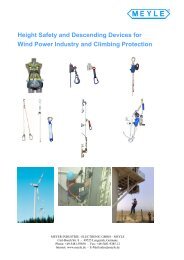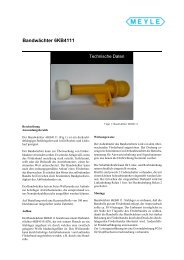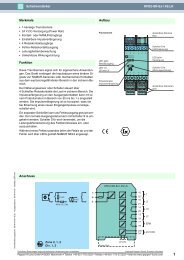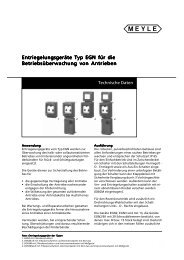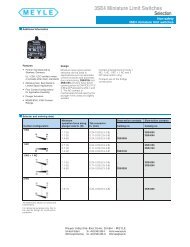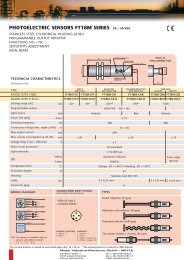INCREMENTAL ENCODER MyInc - MEYER Industrie-Electronic ...
INCREMENTAL ENCODER MyInc - MEYER Industrie-Electronic ...
INCREMENTAL ENCODER MyInc - MEYER Industrie-Electronic ...
You also want an ePaper? Increase the reach of your titles
YUMPU automatically turns print PDFs into web optimized ePapers that Google loves.
12<br />
GENERAL/OVERVIEW<br />
General<br />
Pulse frequency: The required pulse frequency can be calculated.<br />
This is based on the number of pulses<br />
per turn (ppr) and the speed (rpm). The max.<br />
pulse frequency is listed for each encoder.<br />
Usually it is 300 kHz. Meyle also offers high<br />
resolution encoders with a pulse frequency<br />
of up to 800 kHz.<br />
This diagram can be used for the<br />
most common resolutions as a quick<br />
guide:<br />
Outputs and voltage supplies<br />
(overview):<br />
required pulse frequency [kHz]<br />
350<br />
300<br />
250<br />
200<br />
150<br />
100<br />
Meyer <strong>Industrie</strong>-<strong>Electronic</strong> GmbH – MEYLE<br />
Carl-Bosch-Straße 8<br />
49525 Lengerich/Germany<br />
5000 ppr<br />
Tel.: +49 54 81-93 85-0<br />
Fax: +49 54 81-93 85-12<br />
Example<br />
of how to calculate the required pulse frequency<br />
fmax: Given: Speed n= 3000 min-1 Resolution of the encoder<br />
R = 1000 ppr<br />
f max = n x R<br />
60<br />
The required pulse frequency is 50 kHz. Now<br />
you can compare this result with the data of<br />
the encoder you would like to choose.<br />
50<br />
speed [min –1 0 2000 4000 6000 8000 10000 120000<br />
]<br />
Meyle offers a wide range of possible outputs and voltage supplies for any application.<br />
Output Inverted signals Voltage supply<br />
RS 422 Yes 5 V DC<br />
RS 422 Yes 10 ... 30 V DC or 5 ... 30 V DC<br />
Push Pull output No 10 ... 30 V DC or 5 ... 30 V DC<br />
Push Pull output Yes 10 ... 30 V DC or 5 ... 30 V DC<br />
Sine wave voltage output Yes 5 V DC<br />
Sine wave voltage output Yes 10 ... 30 VDC<br />
If the encoder is used in an environment with<br />
strong electrical noise and long cables we<br />
highly recommend the use of inverted<br />
signals.<br />
Sensor outputs: The sensor outputs are used if the distance<br />
from the encoder to the control unit is very<br />
long and the voltage supply at the encoder<br />
could drop due to this long distance.<br />
The input impedance of the sensor inputs<br />
(Controller) is very high, and the voltage drop<br />
2500 ppr<br />
on the sensor output line is almost zero. Due<br />
to this it is possible to detect the actual<br />
supply voltage of the encoder (e.g. 4,2 V<br />
instead of 5 V). Based on this information the<br />
controller will increase the voltage supply to<br />
e.g. 5,8 V.<br />
Internet: www.meyle.de<br />
E-Mail: sales@meyle.de<br />
1000 ppr<br />
500 ppr<br />
250 ppr




